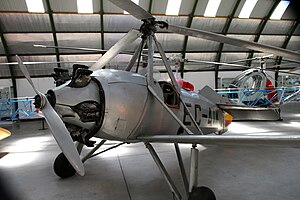| C.12 | |
|---|---|

| |
| A similar, later, autogyro, the Cierva C.19 Mk.4, Museo del Aire, Madrid: NB the C.12 appears to have had a 4-bladed main rotor[1] | |
| Role | Experimental autogyro |
| Manufacturer | Cierva Autogiro Company/Avro |
| Designer | Juan de la Cierva |
| First flight | 1929 |
| Number built | 1 |
The Cierva C.12 was an experimental autogyro built by Cierva Autogiro Company in England in 1929, in association with Avro.
Development
[edit]Like most other Cierva designs, it was based on an existing aircraft fuselage - in this case, an Avro Avian.
Operational history
[edit]The most significant thing about this aircraft is that after initial tests, the Avian's second cockpit was removed, and the aircraft's undercarriage was replaced by the same floats used to equip standard Avian seaplanes. In this configuration, the C.12 (now dubbed the Hydrogiro) flew from Southampton Water in April 1930, becoming the first rotary-wing aircraft to take off from water.
See also
[edit]
References
[edit]- ^ "ejercito_del_aire website showing pictures of licence-built C.12". Archived from the original on 21 May 2015. Retrieved 20 May 2015.
- Notes
- Bibliography
- Taylor, Michael J. H. (1989). Jane's Encyclopedia of Aviation. London: Studio Editions. p. 254.
- World Aircraft Information Files. London: Bright Star Publishing. pp. File 891 Sheet 29.
Well, that’s interesting to know that Psilotum nudum are known as whisk ferns. Psilotum nudum is the commoner species of the two. While the P. flaccidum is a rare species and is found in the tropical islands. Both the species are usually epiphytic in habit and grow upon tree ferns. These species may also be terrestrial and grow in humus or in the crevices of the rocks.
View the detailed Guide of Psilotum nudum: Detailed Study Of Psilotum Nudum (Whisk Fern), Classification, Anatomy, Reproduction